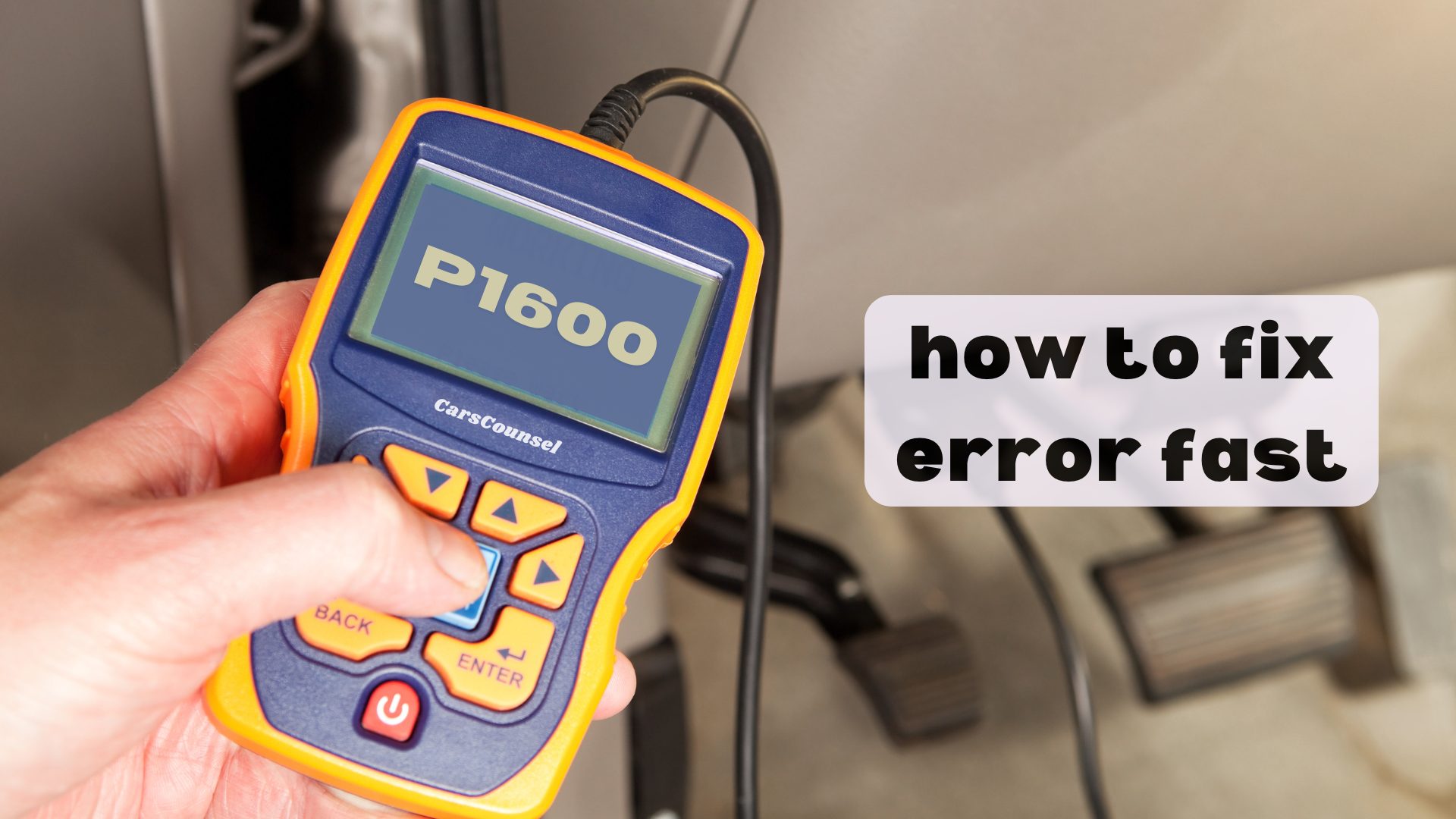Did you know that a P1600 code can make your engine run poorly, leaving you stuck and frustrated?
To fix it fast, start by using a diagnostic scanner to find the OBD2 problem.
Check the wiring for any damage or corrosion, and use a multimeter to test the battery and sensors.
Follow these steps, and you’ll have your engine running smoothly again in no time.

Quick Navigation
Key Takeaways
- Plug in a diagnostic scanner to read and clear error codes. Then, take the car for a test drive to see if the code comes back.
- Look over the wiring and connectors for any damage or rust, and make sure all connections are secure.
- Use a multimeter to check the battery voltage and alternator output to ensure they provide a steady power supply to the ECM.
- Test the sensors (like temperature, airflow, and oxygen sensors) to see if they are faulty. Replace any broken sensors with original parts.
What Is the P1600 Code?
What Is the P1600 Code?
The P1600 code is an error code specific to certain car manufacturers that indicates communication problems between the engine control module (ECM) and other parts of the vehicle. When this code shows up, it usually turns on the check engine light and can cause various performance issues.
Understanding the P1600 code is important for fixing these ECM communication problems. It means the ECM isn’t sending information correctly to other parts of the car, which can affect how your vehicle runs.
Knowing what this code means helps you take quick action to avoid further damage. This code often causes the engine to stall, run poorly, and other issues, so it’s important to fix these communication problems as soon as possible.
Common Causes of P1600
Understanding the P1600 code highlights why it’s important to know its common causes. The main issues are with the ECM (Engine Control Module) and wiring problems. Faulty ECMs can result from internal damage, which leads to communication failures. Corroded or damaged wiring can mess up the ECM’s signals, causing the P1600 code to appear. Loose connections and short circuits can also mess with the ECM’s performance. Factors like temperature and moisture can make these problems worse. Regular checks and maintenance can help prevent these issues.
| Common Causes | Description | Impact |
|---|---|---|
| Faulty ECM | Damage inside the ECM | Communication problems |
| Wiring Corrosion | Damaged or rusted wiring | Signal issues |
| Loose Connections | Poor electrical connections | ECM performance problems |
Fix these issues quickly to avoid more problems.
Impact on Engine Performance
Dealing with a P1600 code can really mess up how your engine runs. You might notice your car stalling, using more gas, or idling unevenly.
This code can make your engine unstable, causing it to hesitate or even shut off suddenly, which can be dangerous. Your fuel usage goes up because the engine can’t manage the air-fuel mix properly.
You’ll also likely experience rough starts and unreliable engine control. If you don’t fix this issue soon, it could lead to more serious and expensive problems.
It’s important to get the P1600 code checked out and repaired to keep your engine running smoothly and avoid bigger repair bills later on.
Affected Vehicle Models
Affected Vehicle Models
The P1600 code can impact how your engine performs, so it’s important to know which cars are most likely to face this issue. The Toyota Prius and Honda Civic are often affected by this error due to problems with the engine control module (ECM), software bugs, or hardware issues.
| Vehicle Model | Common Issues Leading to P1600 |
|---|---|
| Toyota Prius | ECM problems, software/hardware failures |
| Toyota Camry | Hybrid battery issues, low voltage |
| Honda Civic | ECM errors, certain model years |
Knowing which cars are prone to the P1600 code can help you spot and fix problems more easily. If you have one of these cars, keep an eye on regular maintenance and ECM checks to avoid bigger issues.
Recognizing Symptoms of P1600
Recognizing the signs of the P1600 code is important for keeping your vehicle in good shape. You might see your engine not running well or even stalling, which are big clues.
Dashboard warning lights often come on, hinting at possible computer issues. Trouble starting your car and strange engine noises can also suggest a P1600 problem. A noticeable drop in gas mileage is another warning.
To troubleshoot, you can check the wiring, sensors, and battery. If these steps don’t fix the issue, you might need to replace the vehicle’s computer. Addressing these signs quickly can help avoid more damage and keep your car running smoothly.
Regular maintenance is key to preventing future P1600 problems.
Using a Diagnostic Scanner
To diagnose the P1600 code, start by hooking up a diagnostic scanner to your car’s OBD-II port.
Turn on the scanner and follow the instructions on the screen to get the error code. Make sure the scanner works with your car’s make and model to get accurate readings.
When you see the P1600 error code, check for any other codes that might show related problems. This helps you figure out if the issue is a one-off or part of a bigger problem.
Clear the error code from the scanner and take a short drive to see if it comes back. This helps you see if the problem is random or ongoing, which will guide your next steps in troubleshooting.
Inspecting Wiring Issues
After you find the P1600 code with your diagnostic scanner, the next thing to do is to check the wiring thoroughly for any signs of damage, rust, or loose connections.
Start by looking at the wiring harness connected to the ECM. Check for any frayed wires, cracks, or exposed parts. Make sure to inspect all connectors and terminals for rust and ensure they’re clean. Tighten any loose connections you find.
Pay special attention to areas where wires might rub against metal parts, as this can cause wear and short circuits. Use a multimeter to check for continuity and make sure the wiring is in good shape.
Fixing these issues quickly can solve the P1600 code and get the ECM working properly again.
Checking Battery Voltage
Once you’ve made sure the wiring is okay, the next step is to check the battery voltage to see if it’s in the normal range. Keeping your battery in good shape is important for stable voltage, which affects how well the ECM works.
Use a multimeter to check the battery voltage. It should read about 12.6 volts when the engine is off and between 13.7 to 14.7 volts when the engine is running. If the readings aren’t in this range, the battery might be the problem.
- Make sure the multimeter is set to DC voltage.
- Touch the multimeter probes to the battery terminals.
- Check the voltage with the engine off and then again with it running.
- Make sure the readings are within the specified range.
Accurate voltage readings ensure the ECM works correctly.
Evaluating Faulty Sensors
Checking faulty sensors means looking at important parts like the engine temperature, airflow, and oxygen sensors to see if they’re causing the P1600 code.
Start by using a digital multimeter to check the voltage and resistance of each sensor. Compare your results with what the manufacturer says they should be. If your numbers are off, you’ve found a bad sensor.
Next, look at the sensor wires and connectors to see if they’re damaged or corroded. If you find a bad sensor, replace it by taking out the old one and putting in a new one.
Always use original parts to make sure everything works well. By following these steps, you can fix any sensor problems that are causing the P1600 code.
Repairing ECM Issues
Fixing ECM Problems
To fix ECM problems, start by thoroughly checking the module’s connections and internal wiring. Troubleshooting the ECM is key to solving the P1600 code quickly.
First, make sure all connectors are tight and not rusty. Then, test the internal wiring for any breaks or shorts. If you find any internal damage, you might need to replace the module. Always make sure the new ECM matches your vehicle and is correctly programmed.
- Look for rust or damage on connectors
- Check the internal wiring for any breaks
- Look for shorts in the ECM
- Replace the ECM if there are internal problems
Following these steps will help you fix ECM issues effectively.
More OBD-II Codes
Frequently Asked Questions
Can Driving With the P1600 Code Cause Further Damage to My Vehicle?
Yes, driving with the P1600 code can make things worse, like causing poor engine performance and stalling. Problems like a bad ECM or wiring issues could lead to bigger damage if not fixed quickly.
How Long Does It Typically Take to Fix the P1600 Code?
Fixing the P1600 code usually takes a few hours. With the help of diagnostic tools, you can find the problem fast. The cost to repair it depends on whether you need new sensors, wiring, or an ECM, but it’s generally affordable.
Are There Any Temporary Fixes for the P1600 Code?
To temporarily address the P1600 code, you can reset the engine control module (ECM) using diagnostic tools. Make sure all wiring connections are secure and check that the battery is fully charged. These steps might help ease the symptoms for a short time but won’t solve the root problem.
Does the P1600 Code Affect Emissions Testing?
A persistent P1600 code can cause you to fail an emissions test. This code often means your engine isn’t running efficiently, which can lead to higher emissions. Fixing the problem quickly will help you pass the test and keep your car running well.
Is It Safe to Drive My Car With the P1600 Code Active?
It’s not a good idea to drive your car with the P1600 code active. This code can cause problems like poor engine performance and stalling, which can make driving dangerous. Fix the issue right away to avoid more damage to your car and reduce the risk of accidents.
Conclusion
To sum it up, fixing the P1600 code quickly can stop big engine problems.
Did you know that bad wiring causes over 30% of P1600 errors?
By checking and taking care of your car’s wiring, battery, and sensors regularly, you can avoid expensive repairs.
Also, remember to update the ECM software to make sure everything works well.
By staying on top of these things, you can keep your engine running smoothly and efficiently.

